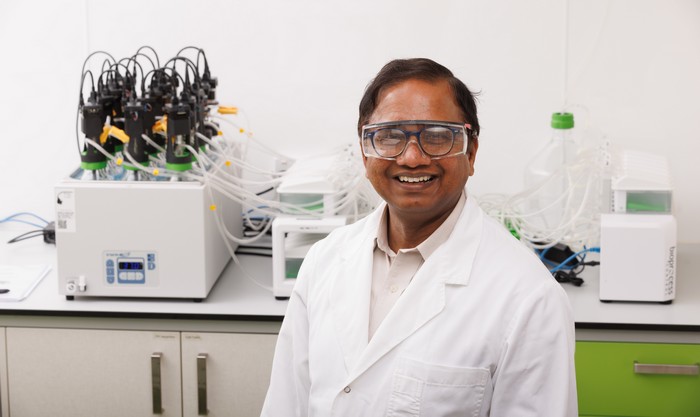Getting to the guts of gas

Converting partly digested grass from the stomachs of slaughtered cattle into biogas that could be used to sustainably heat commercial greenhouses is the focus of a 14-month study at Scion.
It’s hoped the partly digested grass can one day be blended with food waste to develop a powerful new recipe to enhance bioenergy production for industry – making it less reliant on fossil fuels, saving money and benefiting the environment.
Senior scientist and project leader Dr Suren Wijeyekoon says it is well known that cows produce a lot of methane gas when they belch after grass is digested by enzymes in their stomachs.
Taking the same grass, known as paunch grass, from slaughtered animal stomachs and using it to produce methanerich biogas is a research opportunity worth exploring for future bioenergy production replacing natural gas, he adds.
“Each cow has about 10-15kg of partly digested grass in their first stomach when they arrive in an abattoir; that grass normally is disposed of by meat processing companies, which comes at a cost. Our research is looking at the potential to use that waste product to produce biogas at scale, taking it from a small batch to a large pilot study. If successful, it’s research that can be commercially adopted by Ecogas.”
Silver Fern Farms provides the fresh paunch grass for the study. Scion scientists are then deploying Scion’s new biomethane potential test kit to assess the biogas production, which is a mixture of roughly 60% methane and 40% carbon dioxide.
Testing will be complete in October 2023. If successful, it’s hoped the project will be commercially adopted.
The $385,000 study has been jointly funded by Ecogas and the Bioresource Processing Alliance, which works with New Zealand’s primary sector and science partners, including Scion, to get better value out of biological by-products.
AgResearch is also involved in the study by exploring the potential of paunch liquor to be used as a pet food ingredient. Wijeyekoon says the study is a great example of Scion’s research exploring the benefits of a circular bioeconomy.
“There are waste management costs for the disposal of paunch grass currently. Using that one feedstock or waste stream, we can explore a number of new opportunities: bioenergy production, bioCO2 for photosynthesis in greenhouses, digestate for biofertiliser and pet food ingredient production.”
The biogas produced could also satisfy the heat demands of abattoirs in the future, he adds.
Ecogas General Manager Alzbeta Bouskova says the company is excited to partner with Scion in the study and explore the potential of paunch grass as a new clean energy feedstock and, in the process, assist the meat industry with transition to sustainable and circular principles.
For more information, please contact Paul Bennett.
